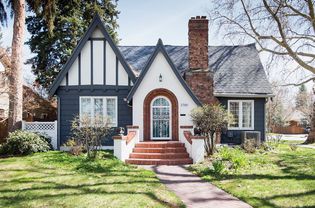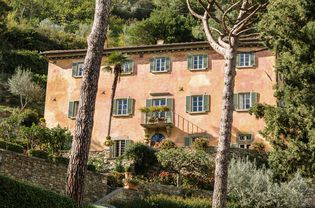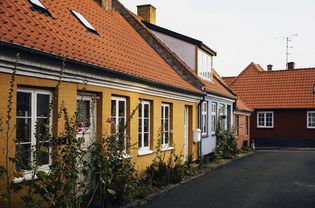Standing out from traditional brick and sided homes in conservative color palettes, a Queen Anne-style house commands attention with its intricate detailing, colorful paint scheme, and unique towers and windows. Renewed interest in old homes has only intensified the search to find and preserve these homes that often feature a fairytale-like, gingerbread house appearance.
A true Queen-Anne house is quite iconic, though this style overlaps with other architectural styles developed during the same time period. This can make distinguishing a Queen Anne home from other Victorian-style houses a bit more complex than you may think. Learn what sets this architectural style apart, along with where it originated and its key features.
What is a Queen Anne-style House?
A subtype of Victorian architecture, Queen Anne-style houses experienced a peak of popularity from the 1880s through the 1910s. They are characterized by an intricate appearance that is a result of artistic and asymmetrical elements, combined with the use of bold, multi-color paint schemes.
Key Characteristics of Queen Anne-Style Houses
A Queen Anne-style home looks very much like a storybook house brought to reality. These artistic houses are covered in intricate detailing, trim, and latticework. Asymmetry is an integral feature of these houses. Towers, turrets, large windows, and multi-gabled, steeply pitched roofs are placed together as if in a puzzle.
Towers are often seen as polygonal or round, a distinguishing feature in Queen Anne-style houses. They are often accompanied by round turrets. Adding to this multi-layered effect, wrap-around porches are commonly seen on Queen Anne houses.
Three or more colors are often used on the exterior, adding to the whimsical feel. The color palette adds depth and emphasizes the intricate details used throughout the architecture. Stained glass can also be seen throughout the large windows, again adding to the colorful, artistic flair of these houses.
Origins of Queen Anne-Style Houses
The houses now known as Queen Anne-style houses trace their start back to the 1700s during Queen Anne’s reign in Britain. The first expressions of Queen Anne-style architecture were subtle and classical in appearance. Still, they boasted impressive facades and intricate details alongside their classical elements. Features were often symmetrical and flat.
In the 1870s, Queen Anne Revival-style houses began appearing with more frequency across Britain but the form factor experienced a shift. The reimagined Queen Anne-style house swapped symmetry for asymmetry. Flat facades were replaced by more three-dimensional features, such as porches and towers.
From the 1880s to 1910s, this Queen Anne Revival style reached America. Here, the style morphed again, resulting in the richly detailed and brightly-hued homes that Queen Anne architecture is known for today. Extremely intricate trim and details cover much of these houses. Multi-color palettes are common, and exteriors are often seen with three or more colors. These lavish details and color combinations were inspired by Eastlake-style houses, another form of Victorian housing.
Queen Anne-Style Houses vs. Victorian Houses
Telling a Queen Anne-style house from other styles of Victorian houses can be a bit tricky. Since Queen Anne-style homes are a branch of Victorian houses, some features overlap. However, when certain features are seen together, this can help you narrow down what kind of Victorian house it is and whether it is considered a Queen Anne-style house.
Intricate details and trim
Often three or more colors for exterior
Rounded towers, turrets, or facades
Wrap-around porches
Asymmetrical facades and features
Complex, asymmetrical roof with steep pitches and multiple gables
Large windows that may feature stained glass
Flat roof
Square towers and turrets
Less detailing
Smaller porches or porticos
Symmetrical lines
No Bay windows
Queen Anne-Style Houses Today
These bold, fairytale-like houses can still be seen in old neighborhoods or towns, and their unique contribution to the architectural world influences bold architects down to this day. At times, the paint scheme or details may have been altered or covered over, requiring some work and a discerning eye to uncover the home's true identity as a Queen Anne-style house.
Many people value the aesthetic of Queen Anne-style homes, restoring their old charm and keeping them in prime condition for many more years of life. This unique style bookmarks an interesting chapter in the Victorian Era, creating a lasting and well-loved style sure to keep its popularity for many years to come.
:max_bytes(150000):strip_icc()/Erica-Puisis-c39951085ba54f3db917710a5ec48084.jpg)
:max_bytes(150000):strip_icc()/_DSC3035-89e8764848db4aa6901d9451b9b15923.jpeg)
:max_bytes(150000):strip_icc()/architecture-gb86d0caf9_1920-c33f8035448b47bbafbb90345153dd45.jpg)



